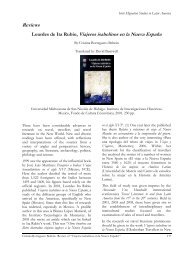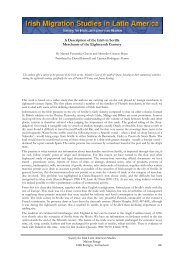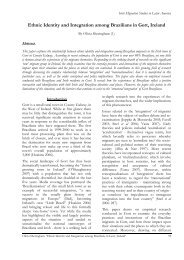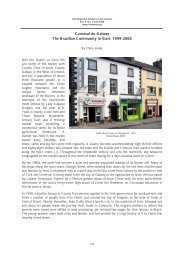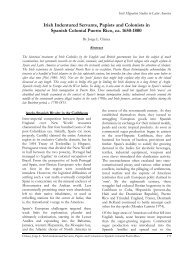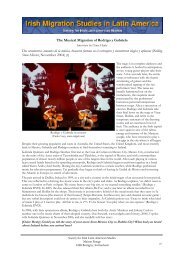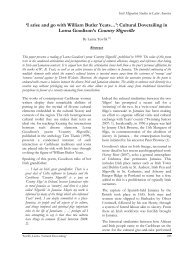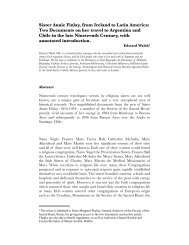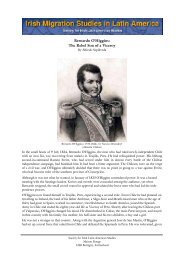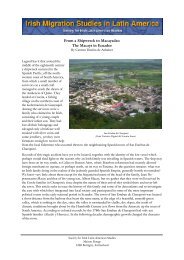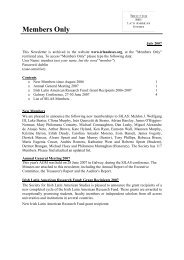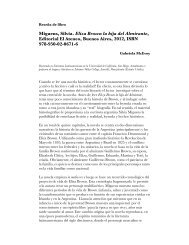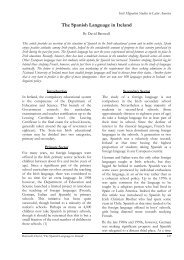I:6 Anti-dumping - Society for Irish Latin American Studies
I:6 Anti-dumping - Society for Irish Latin American Studies
I:6 Anti-dumping - Society for Irish Latin American Studies
Create successful ePaper yourself
Turn your PDF publications into a flip-book with our unique Google optimized e-Paper software.
Fortunately, most of them did not remain with the same family long enough to influence their students<br />
decisively. And we must add that there were some honest schoolmasters who were later successful in other<br />
walks of life.<br />
The camp schoolmasters taught reading, writing and some basic arithmetic, always keeping one step ahead<br />
of the most advanced students. They were also expected to help in household chores; knowledge of<br />
masonry and carpentry were also welcome! Tom Garrahan, who grew up in Lobos, recalled in his memoirs<br />
that during recreation, Mr. George Legates, a <strong>for</strong>mer Glasgow engineer...<br />
“was always occupied at some mechanical work and always kept me to help him, […] so I picked up a lot of useful<br />
knowledge. He was very good at carpentry and he even made a steam engine, a model in wood. All I learned from<br />
him came in handy in after years”. [8]<br />
Children had to learn their prayers and the catechism but parents had little time <strong>for</strong> this. According to<br />
Murray, most schoolmasters would not be useful in this crucial aspect of education, since many of them -<br />
especially the English and <strong>American</strong>s- were Protestants, agnostics or atheists! [9] Such was the price that<br />
many <strong>Irish</strong> settlers paid to have their children educated in their mother tongue.<br />
A s the price that many <strong>Irish</strong> settlers paid to have their children educated in their mother tongue.<br />
A less known aspect is the education of the children of labourers who had no means to pay <strong>for</strong> these<br />
itinerant teachers. According to an embassy report that explained the situation in the mid nineteenth<br />
century, this situation kept a wide sector of the <strong>Irish</strong> community “at the barely-literate level, and, coupled<br />
with their remoteness from urban centres, deprived them of opportunities <strong>for</strong> advancement in a country<br />
that was rapidly becoming prosperous”. [10]<br />
For the members of the <strong>Irish</strong>-Argentine community with means, there existed an alternative option<br />
concerning the education of their children: a boarding school abroad. In 1916, The Southern Cross<br />
published advertisements <strong>for</strong> two boarding schools in Ireland: Saint Enda’s College (Co. Dublin) and<br />
Rockwell College (Cashel). The first one was termed “the <strong>Irish</strong>-Ireland Boarding School <strong>for</strong> Catholic<br />
Boys”, which is hardly surprising, considering that its headmaster was none other than Padraig Pearse,<br />
executed by the British that same year <strong>for</strong> proclaiming the <strong>Irish</strong> Republic. Many <strong>Irish</strong>-Argentine parents<br />
were com<strong>for</strong>table with sending their children to English boarding schools.<br />
The First Schools<br />
In 1856 seven Sisters of Mercy arrived to Buenos Aires. This congregation established by Mother Catherine<br />
McAuley in Dublin (1831) has one peculiarity: to the traditional vows of poverty, obedience and<br />
chastity, they add a fourth one: “the care of the poor, the sick and the ignorant”. [11]<br />
By 1857, they were in charge of a school <strong>for</strong> <strong>Irish</strong> girls in Riobamba Street, city of Buenos Aires. The<br />
<strong>Irish</strong>-Argentine community owed this first school to Father Fahy who had made possible the arrival of the<br />
Sisters and the organisation of the <strong>Irish</strong> College. To begin with, it had five classrooms where 20 boarders<br />
had their lessons, and a school <strong>for</strong> the poor girls of the area.<br />
In 1861 Father Fahy in<strong>for</strong>med that the Sisters had “sixty five boarders, all of them daughters of <strong>Irish</strong><br />
settlers, and also 160 daughters of the natives that received a free education” [12] The 1869 national<br />
census, reflects that the school and the <strong>Irish</strong> Hospital (which was located beside the school) were managed<br />
by 28 Sisters. There were 84 boarders (mostly <strong>Irish</strong>-Argentines), 37 of which were orphans. [13]<br />
In 1865 the Sisters of Mercy opened their second school, Saint Peter and Paul, in Chascomús, but in 1868<br />
this rural district was severely affected by the cholera epidemic and the Sisters lacked the necessary medical<br />
and religious attention. At the same time, their countrymen started the exodus to the northwestern area of<br />
the province of Buenos Aires.<br />
Saint Peter and Paul closed down, and a short time later (1872) they inaugurated another school with the<br />
same staff in Mercedes, a flourishing district with 14,000 inhabitants and a resident <strong>Irish</strong> chaplain. The<br />
Sisters bought land close to the train station and built Saint Joseph’s, a school that had to close when the<br />
Sisters left the country. [14]<br />
The departure was motivated by the uncertainty that followed the closure of the <strong>Irish</strong> Hospital in 1874<br />
and the violent anti-clerical campaign in which the neighbouring Colegio del Salvador was set on fire. The<br />
Sisters left the country in February 1880, and eventually arrived to Australia, where they established<br />
different institutions.<br />
María José Roger, The Children of the Diaspora .................................................................................. 7



